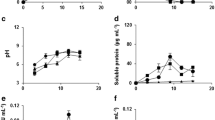Summary
Rhodospirillum rubrum needs exogenous carbon and nitrogen sources in addition to reserve material for bacteriochlorophyll synthesis in anaerobic cultures in the dark. Under these conditions fructose is a good substrate for growth and synthesis of bacteriochlorophyll. The utilization of fructose is adaptive and quantitatively dependent on the amount of reserve materials. The rate of pigment synthesis is increased after a lag phase of several hours. An aerobic preincubation with fructose reduces the lag phase to about 50%. During the first 2–4 h the rate of bacteriochlorophyll synthesis is lower when the cells are provided with fructose than with malate. After this time the production of bacteriochlorophyll on fructose is accelerated, whereas the synthesis rate on malate remains constant.
Cells which have been preadapted on fructose aerobically in the dark are able to synthesize pigment in a following anaerobic dark culture even in the absence of reserve materials. However, the rate of synthesis is lower than in the presence of reserve materials. The drop of pH by fermentation products and the resulting decrease of synthesis rate are removed by the addition of CaCO3. The fermentation metabolism on fructose enables the cells not only to synthesize pigment but also to grow and to form thylakoids. Fructose also is a good substrate in photosynthetic cultures. However, the synthesis of bacteriochlorophyll at the beginning of the anaerobic light culture likewise is related to the presence of reserve materials and to the preculture conditions.
Zusammenfassung
Für eine signifikante B.-Chlorophyllbildung anaerob im Dunkeln ist bei Rhodospirillum rubrum neben Reservestoffen in den Zellen ein exogenes Substrat und eine N-Quelle notwendig (NH4 +). Fructose kann in anaerober Dunkelkultur als Substrat für die B.-Chlorophyllbildung dienen. Die Verwertung ist aber adaptiv und stark vom Gehalt an Reservesubstanzen abhängig. Eine Steigerung der Pigmentsynthese tritt erst nach einer mehrstündigen lag-Phase ein, die durch eine aerobe Vorbebrütung mit Fructose um etwa die Hälfte verkürzt werden kann. Die Syntheserate des B.-Chlorophylls ist in den ersten 2–4 Std mit Fructose geringer als mit Malat als Substrat, steigt dann aber stark an, während mit Malat die Rate etwa konstant bleibt.
Aerob im Dunkeln mit Fructose vorbebrütete Zellen können auch ohne Reservesubstanzen in anschließender anaerober Dunkelkultur Pigmente bilden. Die Syntheserate ist aber geringer als mit Reservesubstanzen.
Eine Pufferung mit CaCO3 (pH>6) erhöht die B.-Chlorophyllsynthese.
In Gegenwart von Fructose finden unter anaeroben Bedingungen im Dunkeln nicht nur eine Pigmentbildung, sondern auch nach einer mehrstündigen lag-Phase eine Thylakoidmorphogenese und Wachstum statt.
Es konnte somit gezeigt werden, daß bei Athiorhodaceen (R. rubrum) eine echte Gärung stattfindet, die Pigmentsynthesen, Bildung von Membranstrukturen und Wachstum ermöglicht.
In anaeroben Lichtkulturen ist Fructose ein gutes Substrat. Die B.-Chlorophyllsynthese ist zu Beginn der anaeroben Lichtkultur ebenfalls von Reservesubstanzen und der Vorkultur abhängig.
Similar content being viewed by others
Abbreviations
- B.-Chlorophyll:
-
Bacteriochlorophyll
- R8, R7, R6 und P, PO4 '''-Puffer:
-
Nährlösungen und Phosphatpuffer (s. Methodik)
Literatur
Biedermann, M., G. Drews, R. Marx u. J. Schröder: Der Einfluß des Sauerstoffpartialdruckes auf das Wachstum, die Synthese von Bacteriochlorophyll und die Thylakoidmorphogenese in Dunkelkulturen von Rhodospirillum rubrum. Arch. Mikrobiol. 56, 133–147 (1967).
Cohen-Bazire, G., W. R. Sistrom, and R. Y. Stanier: Kinetic studies of pigment synthesis by non-sulfur purple bacteria. J. cell. comp. Physiol. 49, 25–35 (1957).
Drews, G.: Die Isolierung schwefelfreier Purpurbakterien. Zbl., Bakt., I. Abt. Orig. Suppl. Heft 1, 170–178 (1965).
Gibson, M. S. and C. H. Wang: Utilization of fructose and glutamate by Rhodospirillum rubrum. Canad. J. Microbiol. 14, 493–498 (1968).
Gottschalk, G.: Verwertung von Fructose durch Hydrogenomonas H 16. II. Cryptisches Verhalten gegenüber Glucose. Arch. Mikrobiol. 49, 96–102 (1964).
— U. Eberhardt u. H. G. Schlegel: Verwertung von Fructose durch Hydrogenomonas H 16 (1). Arch. Mikrobiol. 48, 95–108 (1964).
Lowry, O. H., N. J. Rosebrough, A. L. Farr, and R. J. Randall: Protein measurement with the folin phenol reagens. J. biol. Chem. 193, 265–275 (1951).
Scardovi, V.: Studi sul metabolismo delle Athiorhodaceae. Nota 111 ricerche preliminari sul metabolismo degli aminacidi in Rhodopseudomonas vanielli e Rhodospirillum rubrum. Ann. Microbiol. 7, 141–153 (1957).
Schön, G.: Der Einfluß von Amytal, 2,4-Dinitrophenol und Phenazinmethosulfat auf die Bacteriochlorophyllsynthese in anaeroben Kulturen von Rhodospirillum rubrum. Arch. Mikrobiol. 61, 187–194 (1968a).
Schön, G.: In Vorbereitung (1968c).
Schön, G.: In Vorbereitung (1968d).
—, u. G. Drews: Einfluß der Reservestoffe auf die Bacteriochlorophyllbildung in anaeroben Dunkel- und Lichtkulturen von Rhodospirillum rubrum. Arch. Mikrobiol. 54, 109–214 (1966).
Smith, J. H. C., u. A. Benitez: Chlorophylls. In: Moderne Methoden der Pflanzenanalyse. Hrgs. K. Paech u. M. V. Tracey. 4. Bd., S. 179 Berlin-Göttingen-Heidelberg: Springer 1955.
Sojka, G. A., G. A. Din, and H. Gest: Integration of energy conversation and biosynthetic processes in bacteriae photosynthesis. Nature (Lond.) 216, 1021–1022 (1967).
Stanier, R. Y.: Formation and function of the photosynthetic pigment system in purple bacteria; in: The photochemical apparatus, its structure and function. Brookhaven Symp. Biol. 11, 43–53 (1958).
Szymona, M., and M. Doudoroff: Carbohydrate metabolism in Rhodopseudomonas spheroides. J. gen. Mikrobiol. 22, 167–175 (1960).
Van Niel, C. B.: The culture, general physiology, morphology and classification o the nonsulfur purple and brown bacteria. Bact. Rev. 8, 1–117 (1944).
Author information
Authors and Affiliations
Rights and permissions
About this article
Cite this article
Schön, G. Fructoseverwertung und Bacteriochlorophyllsynthese in anaeroben Dunkel- und Lichtkulturen von Rhodospirillum rubrum . Archiv. Mikrobiol. 63, 362–375 (1968). https://doi.org/10.1007/BF00412122
Received:
Issue Date:
DOI: https://doi.org/10.1007/BF00412122




